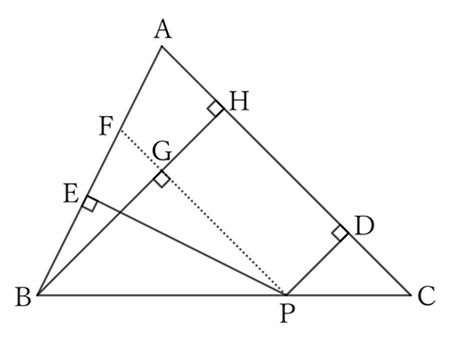Problem
In a triangle $ABC$, let $AC>AB$.
Let the perpendicular line from $B$ to $AC$ be $BH$.
Let the perpendicular lines from a point $P$ on $BC$ to $AB$ and $AC$ be $PE$ and $PD$, respectively. Then
$$PD+PE>BH.$$
$$ $$
$$ $$
$\downarrow$ $\downarrow$ $\downarrow$ $\downarrow$ $\downarrow$
$$ $$
$$ $$
$$ $$
$$ $$
$$ $$
$$ $$
$$ $$
$$ $$
$$ $$
$$ $$
Solution

Draw a line parallel to $AC$ through $P$, and let $F$ and $G$ be the intersections of $AB$ and $BH$.
In$ △FBP$,
$$FP>FB. \qquad (∵ \ AC>AB)$$
Moreover, since $PE⊥BF$ and $BG⊥PF$, from the problem $0072$,
$$PE>BG,$$
$$∴ \ PE+PD>BG+PD,$$
$$∴ \ PE+PD>BG+GH, \qquad (∵ \ PD=GH)$$
$$∴ \ PD+PE>BH.$$
$ $
$ $
$ $
Reference Teiichiro Sasabe (1976) The Encyclopedia of Geometry (2nd edition), Seikyo-Shinsha, pp.39-40.